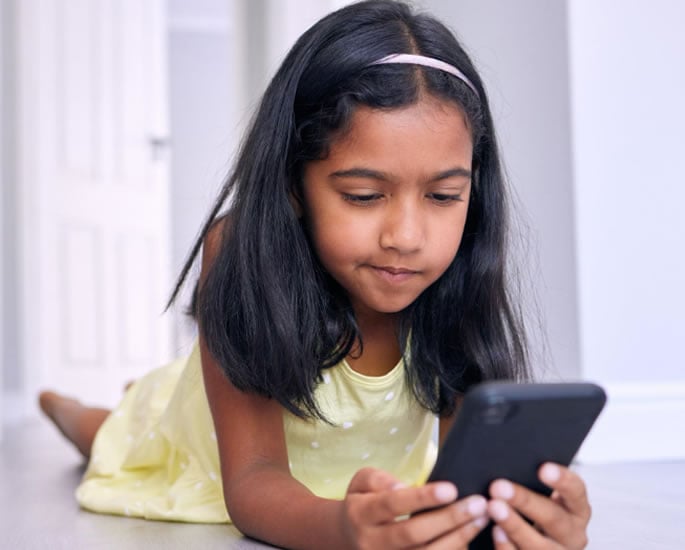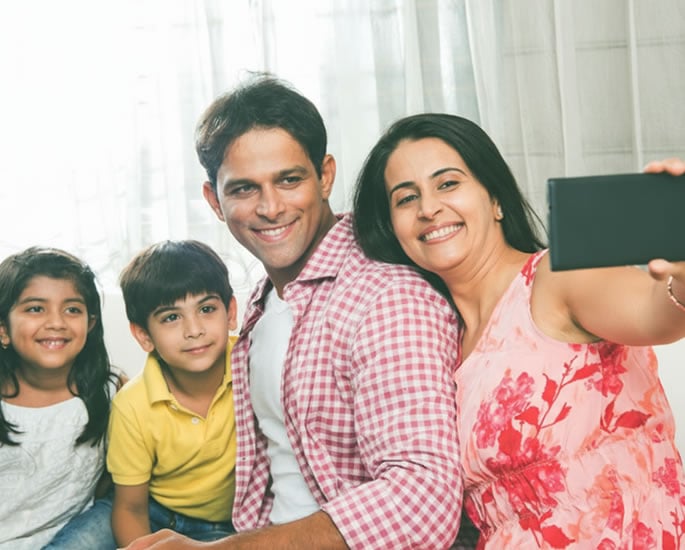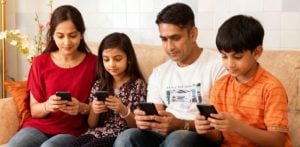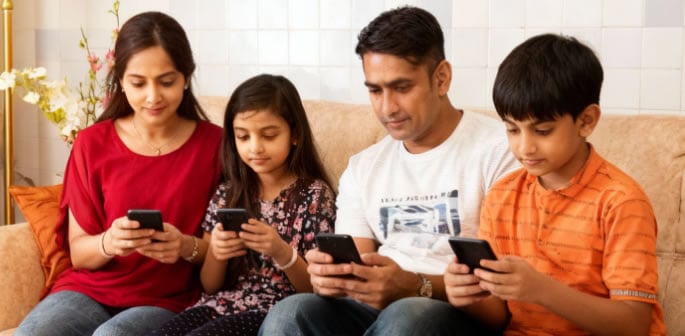a significant source of conflict between them.
The faint blue glow of a smartphone screen is now as common in Indian households as the aroma of morning chai.
These powerful devices have woven themselves into the very fabric of family life, altering communication, changing social dynamics, and presenting both unprecedented opportunities and complex challenges.
From bustling metropolises like Mumbai and Delhi to the quietest rural villages, the smartphone has become an indispensable tool, a primary source of entertainment, and, increasingly, a point of contention.
This digital revolution is not just about technology; it’s about the fundamental reshaping of relationships and the redefinition of what it means to be a family in modern India.
The intricate dance between connection and disconnection, played out on small screens, is a defining feature of the contemporary Indian domestic landscape and it is impacting families.
Connected Yet Disconnected

Smartphones promised a world of seamless connection, and in many ways, they have delivered.
For families spread across cities and even continents, WhatsApp groups and video calls have become lifelines, bridging physical distances and allowing grandparents to witness a grandchild’s first steps from thousands of miles away.
They have empowered families with access to information, from educational resources for children to vital health advice for elders. However, this constant connectivity has also given rise to a perplexing paradox.
Within the four walls of a home, the very devices that connect us to the outside world can build invisible barriers between family members.
The phenomenon of “phubbing”, snubbing someone in a social setting by looking at your phone, has become a common grievance.
Mealtimes, once sacred opportunities for conversation and bonding in India, are now often punctuated by the pings of notifications and the silent scrolling through social media feeds.
A study by vivo and CyberMedia Research (CMR) highlights this growing tension, revealing that 73% of parents and 69% of children in India identify excessive smartphone usage as a significant source of conflict between them.
The study, titled ‘Impact of Smartphones on Parent-Child Relationships’, underscores a troubling reality: while families are more digitally connected than ever, they are struggling to maintain meaningful face-to-face interaction.
The shared silence of a family engrossed in their individual screens is a powerful symbol of this modern-day predicament.
The Generational Divide

The impact of smartphones on children and young adults has become a major concern for parents across India.
Unlike previous generations, today’s children are “digital natives”, born into a world where smartphones are ubiquitous.
This has created a new generational divide, with parents often struggling to navigate the complexities of their children’s online lives.
Issues such as screen time, exposure to inappropriate content, cyberbullying, and the pressures of social media are now central to the challenges of modern parenting.
Medical experts have raised alarms about the effects of excessive mobile phone use on the cognitive development and mental health of children and young adults.
The vivo-CMR study found that children spend over four hours a day on their smartphones, with a staggering 64% of them admitting to feeling addicted.
This dependency has tangible consequences.
The study revealed that 66% of parents and 56% of children have noticed negative changes in their personal relationships due to excessive smartphone usage.
Interestingly, children seem to be more aware of the adverse effects than their parents, with one in three wishing that some of the most popular social media apps had never been invented.
This suggests a growing desire among young people for a more balanced relationship with technology, even as they find it difficult to disconnect.
Two Digital Indias

The smartphone revolution in India has not been a uniform phenomenon.
While affordable data plans and the proliferation of budget-friendly devices have dramatically increased smartphone penetration, a significant digital divide persists.
In urban, affluent families, the challenges often revolve around managing an overabundance of technology: multiple devices, high-speed internet, and a plethora of apps and online services.
The focus here is on curbing excessive use and promoting digital well-being.
In contrast, for many families in rural and economically disadvantaged communities, the struggle is one of access.
While smartphone ownership has increased in rural India, with some reports suggesting that 88% of households now have a smartphone, barriers such as limited digital literacy, the cost of data, and the availability of relevant local language content remain significant hurdles.
For these families, the smartphone is often a shared resource, a gateway to education, financial inclusion, and government services.
However, the lack of digital literacy can also expose vulnerable users to online scams and misinformation.
This digital divide means that while one part of India is grappling with the problems of digital excess, another is still striving for digital inclusion.
Navigating the Digital Future

The integration of smartphones into Indian family life is an ongoing process, and there is a growing recognition of the need to find a healthier balance.
This is not about rejecting technology but about learning to use it more mindfully.
Initiatives like vivo’s “Switch Off” campaign, which encourages families to prioritise real-life relationships, reflect a broader societal conversation about responsible smartphone usage.
The study’s finding that 75% of parents worry about their children’s ability to develop meaningful relationships is a powerful indicator of this concern.
Families are beginning to experiment with solutions, such as setting screen time limits, creating “phone-free” zones in the home, and engaging in open conversations about the impact of technology.
The fact that 94% of children, when asked to design a phone for their parents, would exclude gaming and social media apps speaks volumes about their desire for more present and engaged parenting.
It is a clear call for a shift in priorities, a recognition that genuine connection cannot be mediated through a screen.
Smartphones have proven to be a transformative force in Indian families, a double-edged sword that offers both connection and isolation, empowerment and distraction.
It has redrawn the lines of communication, created new challenges for parents, and highlighted the existing socioeconomic disparities in the country.
As Indian families continue to navigate this complex digital landscape, the key will be to harness the power of technology to strengthen, rather than weaken, the bonds that tie them together.
The journey towards a healthy digital equilibrium is not a simple one, but it is a necessary one, for in the quiet moments between the notifications and the endless scrolling lies the enduring importance of human connection.






























































